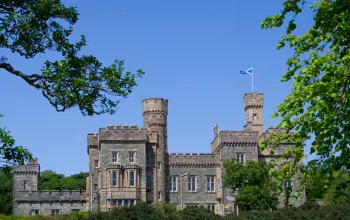THE MARDALE HORSESHOE, LAKE DISTRICT
This marvellous seven-mile walk is an excellent winter option as it can be done in around five hours, so the shorter daylight hours are not a major consideration.
The start point at the far end of Haweswater takes you up onto Rough Crag where you may see a golden eagle soaring above the broad shoulders of Kidsty Pike off to the north, or over the deep blue waters of Blea Water as you clamber up on to 2718-ft High Street.
The views in clear conditions are mighty, taking in huge swathes of the Lakes and stretching as far as the Howgill Fells, the Pennines and the Scottish Lowlands.
The undulating second leg of the walk takes in the summits of Mardale Ill Bell (2496 ft) and Harter Fell (2552 ft) before the final descent down the old packhorse route alongside Gatescarth Beck and back to the car park.
TOP WITHINS, WEST YORKSHIRE
This is a walk best done in winter since there’s heaps more atmosphere then. Why? Well, Top Withins is supposedly the site of/inspiration for Emily Bronte’s famous novel ‘Wuthering Heights’ so you really do want lowering cloud, scudding winds and the promise of a warm, cosy pub at the end of the walk to experience it properly.
The walk is actually an easy 2.5 mile round trip from Bronte Waterfall to the west of Haworth, climbing gently up from the fields and pasture land onto the ‘wild and windy moor’ as Kate Bush would have it.
The short length of this walk makes it perfect for a mid-winter afternoon before heading back to Haworth and a pint at the Fleece Inn on Main Street.
THE PRESELI HILLS, PEMBROKESHIRE
Snow in Pembrokeshire is not too common but if you catch the Preselis when they’re winter white you’re in for a real treat, what with quiet footpaths, marvellous coastal views and a very fine hostelry at the end of it all.
The start and finish point is Tafarn Sinc (Zinc Tavern), a traditional Welsh pub with woodburning stove, sawdust strewn about the floor and its own brew.
From the pub car park a short trudge along tarmac takes you to a bridleway which climbs quite steeply northwards up the slopes of Cwmcerwyn and in less than an hour will see you on the summit and the highest person in southwest Wales.
From here a gentle descent leads you to the evocatively named Golden Road, a 5,000-year-old bridleway running atop the spine of the Preselis, then it’s down through Pantmaenog Forest, and back to the pub.
CARN MOR DEARG ARÊTE, BEN NEVIS
This this is a serious winter outing on the imposing slopes of Ben Nevis by one of the mountain’s most spectacular routes, the Carn Mor Dearg arête.
You ascend initially through forests and along the bank of the Allt a’ Mhuilin, eventually clambering up onto a grand, high shoulder that leads inexorably up and over Carn Bearg Dearg (3,314ft), Carn Dearg Meadhonach (3,870ft) and Carn Mor Dearg (4,012ft).
A nimble, crampon-footed dance across the narrow arête leads you onto the final push to the Ben’s summit and superb mountain panoramas before heading back down past Lochan Meall an t-Suidhe and along the banks of the Allt a’ Mhuilin to finish off a fantastic winter walk.
ROSEBERRY TOPPING, CLEVELAND
Despite its very modest height Roseberry Topping has one of the most distinctive profiles of any hill in northern England, and looks particularly grand when covered with snow – in fact the Vikings who once lived hereabouts considered it sacred and named it ‘Odin’s Hill’.
The ascent is a little over 1,000-feet and can easily be done in an afternoon; from the summit you’ll enjoy a superb panorama which takes in everything from the North York Moors to the Cleveland plain, Teesmouth and even the boyhood home of Captain Cook, Airey Holme Farm.
CRIB GOCH, SNOWDONIA
Just to prove that anything Scotland can do Wales can do too, Crib Goch on the flanks of Snowdon will provide most people with all the thrills they’re likely to want on a winter walk.
This narow ridge when covered in snow has a positively alpine atmosphere to it, and with drop-offs of several hundred metres on either side in places it isn’t one for the faint of heart or sufferers of vertigo.
Access is quick and easy from the car park at Pen-y-Pass, following an easy footpath before you eventually scramble up Crib Goch, tiptoe along its spine and finish off with the brief hike onto the summit of Snowdon.
A more thrilling day out in Snowdonia would be hard to find – but ensure you know how to use ice axe and crampons if taking on Crib Goch in full winter conditions.
CRINKLE CRAGS, LAKE DISTRICT
Sitting above Great Langdale, the evocatively named Crinkle Crags provide a great winter walk.
The usual and best route takes in not just Crinkle Crags (so named after the five ‘crinkles’ in the fells’ summit) but also Cold Pike, Rossett Pike, Pike o’ Blisco and Bowfell and can be a big day in winter conditions, but you can cut it short by missing out Bowfell (which requires a short ‘there and back’ walk) or even just tackling Crinckle Crags on its own.
Try the whole round though; once you’re up on top of the fells there’s a feeling of airy freedom as you stride out that more than repays the effort, and with tremendous views across some of the loveliest scenery in one of the loveliest places on the planet this is a walk that once done you’ll come back to again and again.
HOLKHAM BAY, NORFOLK
Some would say that summer is the best time to visit the vast stretch of golden sand and jade green sea that makes up Holkham Bay, but winter has its own special attractions.
Wrap up warm and wander westwards from Wells-next-the-Sea on a leisurely stroll between the North Sea and Holkham National Nature Reserve, where you’ll find an enticing mix of landscapes including grazing marsh, woodland, salt marsh, sand dunes and foreshore.
The nature reserve is the largest in England and an important habitat for wintering wildfowl, especially Pink-footed Geese, Eurasian Wigeon and Brent Geese as well as breeding waders.
Look out for the wildlife and enjoy the atmospheric winter light across the beach, which is several miles long; it may be flat but with the cold winter wind whipping against your face you’ll still know you’ve had a good walk when you get back to Wells-next-the-Sea.
PEN-Y-GHENT, NORTH YORKSHIRE
Which of the Yorkshire Three Peaks you single out as the ‘best’ is a moot point, but the six-mile, three-hour loop to the summit of 2,278-ft Pen-y-Ghent from Horton-in-Ribblesdale is a fine walk for a winter afternoon by anyone’s standard.
The paths are easy to follow and well-signposted and the walk can be done clockwise or anti-clockwise, with the latter probably being preferable as the steep upper shoulder of the peak is an easier ascent then descent.
From the summit the other Three Peaks of Whernside and Ingleborough (both slightly hogher than Pen-y-Ghent are readily visible, and beyond the view stretches out across much of the Yorkshire Dales and, in the distance, to the fells of the Lake District.
PEN-Y-FAN, BRECON BEACONS
At 93 feet shy of 3,000 feet Pen-y-Fan is the highest mountain in southern Britain, and consequently has some of the finest views in the south of the British Isles too, taking in much of South Wales and even the coastlines of Cardigan Bay, Somerset and Devon on a clear day.
The summit is often dusted with snow throughout the winter, and accessing it is relatively easy on the popular Storey Arms route, a roughly four-mile long there-and-back trail which is almost impossible to get lost on, so wide and obvious is the footpath.
That said people do get lost here – along the way you’ll see a memorial to 5-year-old Tommy Jones, a miner’s son from Maerdy, who got lost on Pen-y-Fan in 1900 while visiting his grandparents. His body was found 29 days later.
Young Tommy got lost in summer, but bear in mind that Pen-y-Fan can be more challenging than it looks in winter conditions…





















